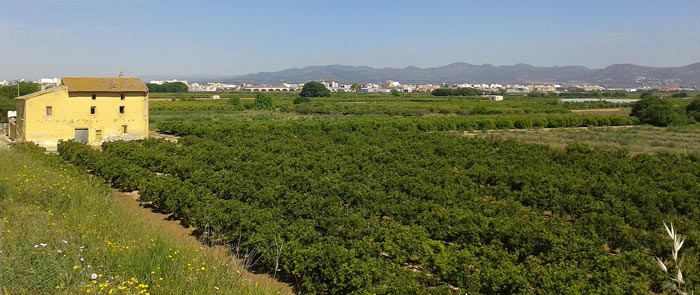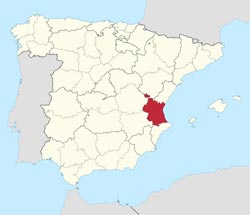Valencia in Valencia

Valencia is the northernmost province in the autonomous region of the same name. It borders on the Mediterranean Sea to the east, on the provinces of Castellon and Teruel to the north, Cuenca and Albacete to the west and Alicante to the south. It also has a small exclave, Rincón de Ademuz, squeezed in between Cuenca and Teruel provinces.
The province of Valencia is undoubtedly best known for its capital of the same name and its endless sandy beaches and tourist resorts. But the province also has a beautiful interior well worth seeing. It is dominated by mountain ranges such as the Iberian and the Betica ranges. The highest point in the province is Pico Calderón in the Macizo de Javalambre. It reaches 1,838 MASL and is situated between Valencia and Teruel; it is a fairly easy hike to get to the top which is a popular destination amongst trekkers.
 The many mountain ranges are traversed by great rivers which have created steep valleys and a large mesa in the middle of the province which has an average altitude of 750 MASL. The province of Valencia also boasts Spain’s second largest coastal plain set between the rivers Júcar and Turia along their lower stretches. The capital of Valencia, Valencia, is home to more than 800,000 of the provinces 5,045,885 inhabitants, which makes it Spain’s third largest city after Madrid and Barcelona.
The many mountain ranges are traversed by great rivers which have created steep valleys and a large mesa in the middle of the province which has an average altitude of 750 MASL. The province of Valencia also boasts Spain’s second largest coastal plain set between the rivers Júcar and Turia along their lower stretches. The capital of Valencia, Valencia, is home to more than 800,000 of the provinces 5,045,885 inhabitants, which makes it Spain’s third largest city after Madrid and Barcelona.
Valencia is also the capital of the whole of the autonomous community of Valencia which comprises the provinces of Castellon, Valencia and Alicante. The city of Valencia, which is situated on the banks of the river Turia near its estuary as it flows into the Mediterranean Sea, has been an important population centre for more than 2,000 years. It was founded by the Roman consul Decimus Junius Brutus Callaicus in 138 BC. About 2,000 colonists settled on the site of a former Iberian settlement, and their descendants formed one of the so-called ‘fully Romanised cities’ in the Roman Hispania with nearly all the population made up by descendants of Romans from the Italian peninsula. When the Roman imperial administration crumbled, Valencia lived through a couple of tumultuous centuries with hardly any new developments in the city until the advent of the Moors. The city prospered once again under Muslim rule and did booming trade in paper, silk, leather, ceramics, glass, and silver work. After many Christian attempts, Valencia was finally conquered back into the Christian fold by King James I of Aragon in 1238. Fifty thousand Moors were forced to leave, and after the expulsion the city was divided between those who had participated in the conquest. Valencia lived through its golden age in the 15th century. It was a time of economic expansion, and culture and the arts flourished. However, when the Americas were discovered in 1492, all of Europe’s trade and interests turned west, and Valencia entered into a long decline which was not to reach its nadir until more than 200 years later. Under Bourbon rule, the city started its long upwards climb back to prosperity, which was to increase almost non-stop, even up until the present day.
The climate in Valencia is hot in summer and mild in winter. January is the coldest month, but snow and below-zero temperatures are rare. The hottest month is August with the average maximum temperature in the early thirties, the average minimum in the early twenties. Rain is most abundant in September and October and is usually about 500mm a year, although later years, through climate change, have seen massive downpours – like only last month when the city and province in one day registered rainfall of up to 200 mm, the majority of it in just one hour. During sudden rainfalls like that, the river Turia overflows and floods parts of the city. Valencia has two urban beaches with fine, golden sand: Playa de las Arenas and Playa de la Malvarrosa, which border to the south on the large port of Valencia. These two city beaches have a long seafront promenade lined with numerous premises offering places to stay and local gastronomy. The beaches south of the Turia river are less bustling and offer a 15 km stretch of sandy coastline, protected by dunes and surrounded by the Albufera natural park. The Port of Valencia is an important and integral part of the city. With a total ground area of 5,603,186 m2 and 13,232 meters of docking distributed on 15 piers, it is the largest port in Spain and the whole Mediterranean basin, and the fourth busiest port in Europe. It has a loading capacity of 64 million tons a year, or 6,660,947 TEUs. More than 15,000 employees in the port area administer, service, load, and unload over 7,500 ships a year. Valencia also has a thriving economy in the areas of commerce, industry, tourism and other services and is visited by more than 10 million tourists a year, not least boosted by the city’s prestigious Ciudad de las Artes y las Ciencias, an enormous architectural, cultural and entertainment complex with a stunning design.


